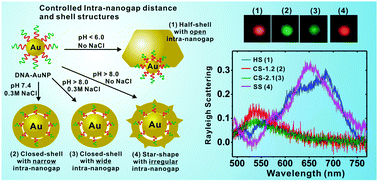DNA-mediated control of Au shell nanostructure and controlled intra-nanogap for a highly sensitive and broad plasmonic response range†
Abstract
We report DNA-mediated simple synthetic methods to obtain anisotropic plasmonic nanostructures with a tailorable intra-nanogap distance ranging from 0.9 to 4.0 nm. Anisotropic half-shell structures with sub-1.0 nm intra-nanogaps showed a wavelength-independent surface-enhanced Raman scattering (SERS) intensity and a highly sensitive SERS response to NIR light. We found that the reaction conditions such as pH and NaCl concentration are responsible for the resulting shell structures and intra-nanogap distances. Three noticeable plasmonic nanostructures [i.e., half-shell with sub-1.0 nm nanogaps, closed-shell with a wide nanogap (2.1 nm) and star-shaped with an irregular nanogap (1.5–4.0 nm)] were synthesized, and solution-based and single particle-based Raman measurements showed a strong relationship between the plasmonic structures and the SERS intensity. An understanding of DNA-mediated control for nanogap-engineered plasmonic nanostructures and studies of SERS-activity relationships using single particle-correlated measurements can provide new insights into the design of new plasmonic nanostructures and SERS-based biosensing applications.


 Please wait while we load your content...
Please wait while we load your content...